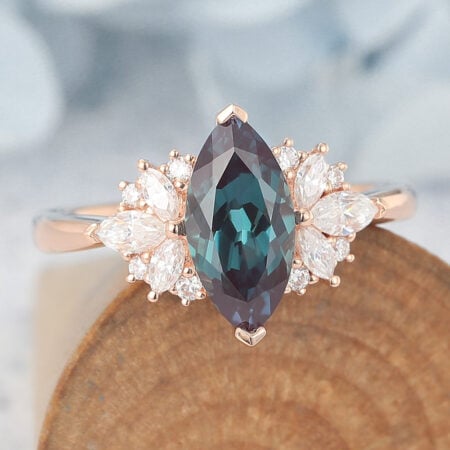A Comprehensive Guide to Alexandrite Stone : History, Hardness, Worth & Symbolism
As one of the world’s rarest precious gemstones, the alexandrite stone captivates with its magical color shift. This remarkable transformation is more than just beautiful—it inspires curiosity, stirs emotion, and evokes a deep sense of wonder. From engagement rings to statement pieces, alexandrite jewelry holds a special place for those drawn to the extraordinary. In the sections ahead, we will explore the facts about alexandrite in fascinating history, unique properties, and lasting value that make alexandrite truly exceptional.
What Is Alexandrite Stone?
The definition of alexandrite identifies it as a chrysoberyl mineral known for its unique crystal structure and remarkable durability. Its chemical composition and physical properties contribute to the stone’s hardness and brilliance. The alexandrite rarity stems from its limited natural deposits, making it an exceptional gemstone prized for both its toughness and distinct qualities.
The History of Alexandrite Stone
The origin of alexandrite dates back to the 1830s when it was first discovered in the Ural Mountains of Russia and named after Emperor Alexander II. At that time, alexandrite was considered a gemstone reserved exclusively for nobility and royalty, symbolizing power and wealth. However, as new deposits were found in other regions, alexandrite was no longer limited to royal ownership and gradually gained a significant place in the global jewelry market.
Where Is Alexandrite Found Today?
Today, alexandrite is found in several countries including Sri Lanka, Brazil, Tanzania, India, and Madagascar. While these sources provide more availability, Natural Russian Alexandrite remains the most valued due to its exceptional quality and rarity.
Types of Alexandrite
Natural Alexandrite – Mined from the earth, rare and prized for authentic color-changing properties.
Lab-Grown Alexandrite – Created in labs with similar chemical and optical features to natural stones.
Simulated Alexandrite – Made from synthetic materials like corundum or glass, imitating the look of real alexandrite.
Russian Alexandrite – High-quality natural variety from Russia, known for vivid and dramatic color change.
Brazilian Alexandrite – A more common natural source today, offering good color shift with better availability.
Sri Lankan Alexandrite – Paler natural variety with softer color transitions, often more affordable.

Alexandrite Stone Hardness and Density
Alexandrite is a durable gemstone with a Mohs scale hardness of 8.5, making it suitable for everyday jewelry like rings and pendants. This impressive alexandrite hardness ensures good resistance to scratching and wear. In terms of physical characteristics, the alexandrite density typically ranges between 3.68 and 3.78 g/cm³, contributing to its solid, substantial feel. Together, these properties enhance the stone’s appeal for both beauty and practicality.
Color-Changing Properties of Alexandrite
Among the rare stones that change color in different light, alexandrite stands out as the most iconic. This unique phenomenon—known as the alexandrite effect—is caused by trace amounts of chromium in the crystal structure, allowing the stone to absorb and reflect different wavelengths of light. The typical colors of alexandrite shift from green or bluish-green in daylight to red or purplish-red under incandescent lighting. This dramatic transformation not only enhances its mystique but also adds to its desirability as a collector’s gemstone.
A List of Color-Changing Gemstones

Genuine Natural Alexandrite Stone Price
The price of genuine natural alexandrite stones can vary significantly depending on factors such as origin, clarity, size, and the intensity of its color change. On average, the alexandrite cost per carat ranges from $5,000 to over $70,000 for high-quality stones, especially those over one carat with strong color-shifting properties. Exceptional stones from historical sources like Russia can fetch even higher prices in auctions or collector markets. Due to its rarity and demand, natural alexandrite remains one of the most valuable gemstones per carat on the global market.
Lab Grown Alexandrite Price
Lab created alexandrite stones provide an affordable yet visually striking alternative to natural varieties. With prices typically ranging from $100 to $500 per carat, these synthetic gems mimic the captivating color-change of genuine alexandrite at a fraction of the cost. Thanks to their accessibility, lab-grown alexandrite is commonly used in fine jewelry such as alexandrite rings, necklaces, and earrings, making it a popular choice for those seeking elegance without the high price tag of natural stones.

Symbolism and Meaning of Alexandrite Stone
The meaning of alexandrite stone is deeply connected to transformation, balance, and creativity. Known as a stone that embodies change, alexandrite encourages adaptability and personal growth by reflecting its shifting colors. Throughout history, it has been seen as a symbol of good luck, prosperity, and emotional healing. Many believe that wearing alexandrite helps to enhance intuition and bring harmony between the heart and mind, making it a meaningful choice for those seeking both beauty and deeper spiritual connection.
The Meaning of Alexandrite as the Birthstone for June
The meaning of June birthstone alexandrite is deeply rooted in transformation and balance. Known for its unique color-changing ability, this gemstone symbolizes adaptability and emotional growth, reflecting the ever-changing nature of life. Traditionally, alexandrite is believed to bring good fortune, creativity, and spiritual insight to those born in June, making it a meaningful and cherished birthstone.
Properties and Benefits of Alexandrite
The benefits of alexandrite gemstone can be divided into several key areas, including its healing properties, spiritual significance, and metaphysical effects. Each aspect contributes to its reputation as a powerful stone for emotional balance and personal transformation:
Healing Properties of Alexandrite
The alexandrite healing properties are valued for promoting emotional balance and physical renewal. This gemstone is believed to reduce stress, enhance vitality, and support overall well-being, helping wearers recover from emotional and physical fatigue.
Spiritual Properties of Alexandrite
Known for its powerful alexandrite spiritual properties, this stone aids in boosting intuition and creativity. It encourages spiritual growth by opening channels to higher awareness and amplifying positive energies around the wearer.
Metaphysical Benefits of Alexandrite
Among the notable properties of alexandrite is its ability to inspire transformation and self-reflection. It helps align the heart and mind, fostering emotional healing and personal development on a deeper level.
How to Identify if an Alexandrite Stone is Real
- Check the color change: A genuine alexandrite shifts from greenish hues in daylight to reddish tones under incandescent light.
- Test the hardness: Alexandrite rates about 8.5 on the Mohs scale and should resist scratches from most common materials.
- Inspect for natural inclusions: Use a jeweler’s loupe to find tiny imperfections, which are common in real stones but rare in synthetics.
- Conduct professional gemological tests: Methods like spectroscopy or measuring refractive index provide accurate confirmation of authenticity.
Final Thoughts
The Alexandrite Stone is more than just a rare gem—it’s a symbol of transformation, strength, and timeless beauty. With its rich history, unique color shift, and enduring value, it continues to fascinate those who seek meaning and elegance in their jewelry.
FAQs About Alexandrite Stone
What color is alexandrite?
Alexandrite typically appears green to bluish-green in daylight and shifts to reddish-purple or raspberry red under incandescent light.
How hard is alexandrite?
Alexandrite has a hardness of 8.5 on the Mohs scale, making it one of the more durable precious gemstones suitable for everyday jewelry.
Is alexandrite rare? How rare is alexandrite?
Yes, alexandrite is extremely rare—especially natural stones with strong color change and high clarity. It’s considered one of the rarest gemstones in the world.
What does alexandrite look like?
It is a transparent, faceted gemstone with a dramatic color change depending on lighting. It often shows a vivid green in daylight and a reddish hue under warm light.
What does alexandrite symbolize?
Alexandrite symbolizes transformation, balance, and inner strength. It’s often associated with personal growth and the harmony between opposites.
Is alexandrite a birthstone?
Yes, alexandrite is one of the modern birthstones for June, celebrated for its rarity and mysterious beauty.
Does alexandrite change colors? Why does alexandrite change color?
Yes, it does. Alexandrite’s unique color change is due to how its crystal structure absorbs light differently under natural and artificial light sources.
How much are alexandrites worth?
Natural alexandrite prices vary widely based on quality, but high-quality stones can range from $5,000 to over $70,000 per carat. Lab-created versions are more affordable.



